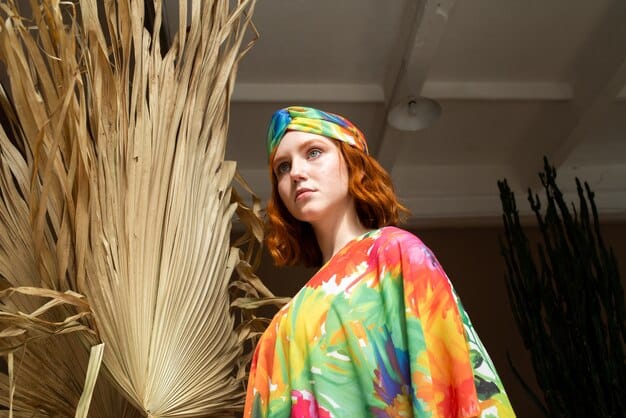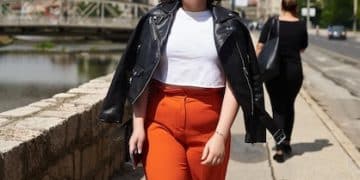Spring 2025: Top 5 Sustainable Fabrics on US Runways

Spring 2025’s runways in the US are set to showcase a shift towards sustainability, highlighting innovative fabrics like organic cotton, recycled polyester, hemp, Tencel, and linen as the top choices for eco-conscious fashion.
Get ready for a sustainable style surge! Spring 2025: Unveiling the Top 5 Sustainable Fabrics Dominating US Runways, promising a season of eco-conscious fashion that doesn’t compromise on style.
The Rise of Sustainable Fashion
Sustainable fashion is no longer a niche trend; it’s a powerful movement reshaping the industry. Consumers are increasingly aware of the environmental and social impact of their clothing choices, driving demand for eco-friendly alternatives. This shift is particularly evident in the United States, where designers and brands are embracing sustainable practices to meet the needs of conscious consumers.
The Growing Consumer Demand
The surge in demand for sustainable fashion is fueled by a desire to reduce waste, minimize pollution, and support ethical labor practices. Consumers are seeking transparency in the supply chain, wanting to know where their clothes come from and how they are made.
Designers Leading the Charge
Innovative designers are at the forefront of the sustainable fashion movement, experimenting with new materials and techniques to create stylish, eco-friendly garments. They are proving that sustainability and high fashion can coexist, inspiring others to follow suit.
- Consumer awareness is driving the demand for eco-friendly clothing.
- Designers are embracing sustainable practices to appeal to conscious consumers.
- Transparency in the supply chain is becoming increasingly important.
- Sustainable fashion is moving from niche to mainstream.
The rise of sustainable fashion signifies a fundamental change in the industry, with both consumers and designers prioritizing environmental and social responsibility. This trend is set to continue in Spring 2025, as evidenced by the latest fabric choices on US runways.
Organic Cotton: A Classic, Reinvented
Organic cotton remains a staple in sustainable fashion, prized for its softness, breathability, and eco-friendly production. Unlike conventional cotton, organic cotton is grown without synthetic pesticides, herbicides, or genetically modified organisms (GMOs), making it a healthier and more environmentally friendly option.
Benefits of Organic Cotton
Organic cotton offers numerous benefits, including reduced water consumption, improved soil health, and lower greenhouse gas emissions. It also promotes safer working conditions for farmers, as they are not exposed to harmful chemicals.
Applications in Spring 2025 Collections
In Spring 2025 collections, organic cotton is being used in a variety of garments, from lightweight dresses and skirts to comfortable tops and denim jeans. Its versatility makes it a popular choice for designers looking to create timeless, sustainable pieces. Expect to see organic cotton blended with other sustainable fibers for enhanced performance and durability.
Organic cotton continues to be a fundamental component of sustainable fashion, valued for its environmental benefits and versatility in various Spring 2025 collections, emphasizing both comfort and eco-consciousness.
Recycled Polyester: Giving Waste a Second Life
Recycled polyester, often made from recycled plastic bottles, is gaining prominence as a sustainable alternative to virgin polyester. This innovative fabric helps reduce landfill waste, conserves resources, and lowers carbon emissions compared to traditional polyester production.
Environmental Advantages
Using recycled polyester significantly reduces the environmental impact of plastic waste. By diverting plastic bottles from landfills and oceans, this material helps combat pollution and protects ecosystems.
Applications in Fashion
Recycled polyester is finding its way into a wide range of fashion items, including activewear, outerwear, and even high-fashion garments. Its durability, wrinkle resistance, and ability to be dyed in various colors make it a versatile choice for designers.
- Reduces landfill waste by repurposing plastic bottles.
- Conserves resources and lowers carbon emissions.
- Used in activewear, outerwear, and high-fashion garments.
- Offers durability, wrinkle resistance, and color versatility.
Recycled polyester exemplifies the circular economy in action, transforming waste into valuable fashion materials for Spring 2025, underlining a commitment to environmental responsibility.
Hemp: A Resilient and Versatile Fiber
Hemp is a fast-growing, low-impact crop that requires minimal water and pesticides, making it an incredibly sustainable fiber. Its strength, durability, and natural texture make it an appealing choice for eco-conscious designers.
The Benefits of Hemp
Hemp cultivation is beneficial for the environment, as it improves soil health, sequesters carbon dioxide, and requires little to no pesticides. Its long fibers are also incredibly strong, making hemp fabrics highly durable.
Hemp in Spring 2025 Designs
For Spring 2025, hemp is being used in everything from structured jackets and trousers to casual shirts and dresses. Designers are experimenting with different weaves and finishes to showcase the versatility of this fiber. Blends with organic cotton and other sustainable materials are also common.
Hemp’s robust environmental credentials and versatile applications are cementing its position in Spring 2025 fashion, offering durable and eco-friendly design choices.

Tencel: Softness with a Small Footprint
Tencel, also known as Lyocell, is a cellulose fiber made from sustainably sourced wood pulp. Its production process is closed-loop, meaning that solvents used in manufacturing are recycled, minimizing environmental impact. Tencel is known for its softness, breathability, and moisture-wicking properties.
Eco-Friendly Production
Tencel’s closed-loop production process ensures that water and solvents are recycled, reducing waste and minimizing pollution. The wood pulp used to make Tencel comes from sustainably managed forests, ensuring responsible sourcing.
Applications in Spring Fashion
Tencel is a popular choice for lightweight dresses, skirts, and tops in Spring 2025 collections. Its smooth texture and excellent drape make it ideal for creating comfortable and elegant garments. Designers are also using Tencel in blends with other sustainable fibers to enhance performance and aesthetics.
The eco-conscious production and luxurious feel of Tencel are making it a staple in Spring 2025 collections, balancing environmental responsibility with elegance and comfort.
Linen: Timeless and Sustainable Elegance
Linen, made from the flax plant, is a durable and breathable fabric that has been used for centuries. Flax requires minimal water and pesticides to grow, making linen a sustainable choice. Its natural texture and timeless appeal make it a favorite among designers and consumers alike.
The Sustainable Qualities of Linen
Flax is a resilient crop that requires little irrigation and few pesticides, making linen production environmentally friendly. Linen is also biodegradable and recyclable, further reducing its environmental impact.
Linen in Spring 2025 Collections
In Spring 2025 collections, linen is being used in a variety of garments, from tailored suits and dresses to casual shirts and trousers. Its natural texture and breathability make it perfect for warm-weather wear. Designers are also experimenting with different colors and finishes to give linen a modern twist.
Linen’s timeless appeal and eco-friendly characteristics are ensuring its presence in Spring 2025 fashion, offering elegant and sustainable options for consumers.
| Key Fabric | Brief Description |
|---|---|
| 🌱 Organic Cotton | Grown without pesticides, healthier for the environment and farmers. |
| ♻️ Recycled Polyester | Made from recycled plastic bottles, reduces waste and carbon emissions. |
| 🌿 Hemp | Low-impact crop, requires minimal water and pesticides, very durable. |
| 🌳 Tencel | Made from sustainably sourced wood pulp, closed-loop production process. |
FAQ
▼
A sustainable fabric is produced using methods that minimize environmental impact, such as reducing water and pesticide use, conserving energy, and promoting fair labor practices. It’s also often made from renewable or recycled materials.
▼
Sustainable fashion addresses the negative environmental and social impacts of the fashion industry, including pollution, waste, and unethical labor practices. It promotes a more responsible and ethical approach to clothing production and consumption.
▼
Look for certifications like GOTS (Global Organic Textile Standard) for organic cotton or labels indicating recycled content. Brands committed to transparency often provide information about their materials and production processes.
▼
Sustainable fabrics can sometimes be more expensive due to higher production costs and ethical sourcing. However, the long-term benefits to the environment and society often outweigh the initial investment, and prices are becoming more competitive.
▼
Consumers play a crucial role by supporting brands that prioritize sustainability, choosing eco-friendly materials, and extending the lifespan of their clothing through proper care and recycling, promoting a circular fashion economy.
Conclusion
As Spring 2025 approaches, the fashion industry is poised to embrace sustainability like never before. Organic cotton, recycled polyester, hemp, Tencel, and linen are leading the charge, offering designers and consumers alike stylish, eco-friendly choices that minimize environmental impact and promote ethical practices.





